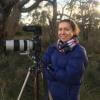Acoustic sensors enable efficient and non-invasive monitoring of a wide range of species, including many that are difficult to monitor in other ways. Although they were initially limited in application scope largely due to cost and hardware constraints, the development of low-cost, open-source models like the Audiomoth in recent years has increased access immensely and opened up new avenues of research. For example, some teams are using them to identify illicit human activities through the detection of associated sounds, like gunshots, vehicles, or chainsaws (e.g. OpenEars).
With this relatively novel dimension of wildlife monitoring rapidly advancing in both marine and terrestrial systems, it is crucial that we identify and share information about the utility and constraints of these sensors to inform efforts. A recent study identified advancements in hardware and machine learning applications, as well as early development of acoustic biodiversity indicators, as factors facilitating progress in the field. In terms of limitations, the authors highlight insufficient reference sound libraries, a lack of open-source audio processing tools, and a need for standardization of survey and analysis protocols. They also stress the importance of collaboration in moving forward, which is precisely what this group will aim to facilitate.
If you're new to acoustic monitoring and want to get up to speed on the basics, check out these beginner's resources and conversations from across the WILDLABS platform:
Three Resources for Beginners:
- Listening to Nature: The Emerging Field of Bioacoustics, Adam Welz
- Ecoacoustics and Biodiversity Monitoring, RSEC Journal
- Monitoring Ecosystems through Sound: The Present and Future of Passive Acoustics, Ella Browning and Rory Gibb
Three Forum Threads for Beginners:
- AudioMoth user guide | Tessa Rhinehart
- Audiomoth and Natterjack Monitoring (UK) | Stuart Newson
- Help with analysing bat recordings from Audiomoth | Carlos Abrahams
Three Tutorials for Beginners:
- "How do I perform automated recordings of bird assemblages?" | Carlos Abrahams, Tech Tutors
- "How do I scale up acoustic surveys with Audiomoths and automated processing?" | Tessa Rhinehart, Tech Tutors
- Acoustic Monitoring | David Watson, Ruby Lee, Andy Hill, and Dimitri Ponirakis, Virtual Meetups
Want to know more about acoustic monitoring and learn from experts in the WILDLABS community? Jump into the discussion in our Acoustic Monitoring group!
Header image: Carly Batist

- 0 Resources
- 2 Discussions
- 1 Groups
Join us in celebrating this year’s Community Choice Award winners!
15 August 2024
Vote for your favorite submissions that best demonstrate conservation impact, novel innovation/discovery, and strong storytelling of the work and the sector.
12 August 2024
On the final day of the #Tech4Wildlife Photo Challenge, we wrap up looking at past and current submissions that feature the fastest growing areas of conservation tech. Today’s topic: bioacoustics!
9 August 2024
We are thrilled to introduce our new horizon scan, which will chart the future of bioacoustics. By collectively prioritizing emerging innovations that could transform the field, we aim to build consensus, facilitate...
5 August 2024
Wildlife Acoustics is proud to offer a grant program to support the advancement of wildlife research, habitat monitoring, and environmental conservation
4 August 2024
Funding
Wildlife Acoustics Scientific Product Grant was introduced to support the advancement of habitat monitoring, and environmental conservation.
26 July 2024
Discover the challenges marine animals face in busy shipping lanes—from the constant noise disrupting their habitats to the threat of ship collisions. Slowing down ships could offer a simple yet effective solution to...
8 July 2024
Manufacturing Partnership Brings Low-Cost Pipistrelle Family of Detectors to Researchers, Ecologists and Bat Enthusiasts Around the World
2 July 2024
Article
One of the most thrilling moments for any researcher is seeing their hard work published for the world to see. As part of the Women in Conservation Technology (WiCT) Kenya Cohort One, we not only learnt about the use of...
17 June 2024
Come join us at AIMS, and work on deep learning for bioacoustics research!
14 June 2024
The San Diego Zoo Wildlife Alliance's Burrowing Owl Recovery Program and Conservation Technology Lab seek a postdoctoral research associate to develop bioacoustic tools for monitoring the western burrowing owl...
11 June 2024
Come and do the first research into responsible AI for biodiversity monitoring, developing ways to ensure these AIs are safe, unbiased and accountable.
11 June 2024
June 2025
July 2025
September 2025
event
October 2025
November 2025
event
61 Products
| Description | Activity | Replies | Groups | Updated |
|---|---|---|---|---|
| Hi Mona. Yes, this is what we certainly what we are considering, but how to measure these indices by the hands of non-experts in the field is the advice that I need from the WL... |
|
Acoustics | 1 day 7 hours ago | |
| Would that be able to process locally stored acoustic data? One of the great things about birdnet analyzer is that it is local - it doesn't require uploading terabytes... |
|
Acoustics | 3 days 22 hours ago | |
| Do you collect or use sound recordings of habitats or species like birds, frogs, mammals, or insects in India? We need your expertise!... |
|
Acoustics | 1 week 2 days ago | |
| My name is Frank Short and I am a PhD Candidate at Boston University in Biological Anthropology. I am currently doing fieldwork in Indonesia using machine-learning powered passive... |
|
Acoustics, AI for Conservation, Animal Movement, Data management and processing tools, Early Career, Emerging Tech, Ethics of Conservation Tech, Protected Area Management Tools, Software Development | 2 weeks ago | |
|
|
Latin America Community, Acoustics, AI for Conservation, Camera Traps, Drones, Early Career | 2 weeks 6 days ago | ||
| There are a lot of parameters in principle here. The size of the battery. How much time in the field is acceptable before a visit? Once a week? Once a month? How many devices you... |
|
Acoustics | 3 weeks 1 day ago | |
| Hi Tom! I think the furry windjammer must be outside the casing to have the desired effect. It can be a bit tricky having this nice furry material that birds and other critters... |
|
Acoustics | 3 weeks 3 days ago | |
| Hi Lana,"similar field setup" means that the vocalizing animal should be surrounded by the recorders and you should have at least 4 audiomoths recording the same sound, then the... |
+9
|
Acoustics | 3 weeks 3 days ago | |
| Fantastic! Can't wait to hear updates. |
|
Acoustics | 4 weeks 1 day ago | |
| New stable release : v1.5.1We are pleased to announce the latest release with several important enhancement, fixes and documentation improvements to ensure compatibility with the... |
+15
|
Acoustics, AI for Conservation, Open Source Solutions, Software Development | 1 month 1 week ago | |
| Hello everyone,Thank you all for your contribution!You can read some updates about this project in this post.Julia |
|
Acoustics, Community Base, Data management and processing tools, Open Source Solutions | 1 month 2 weeks ago | |
| Hi Ryan, hmm, I had no idea there was a microphone named that. I thought about how it’s used to lure birds for netting, and I like Greek Mythology. I thought it was a perfect fit... |
|
Acoustics, Emerging Tech, Funding and Finance, Protected Area Management Tools, Software Development | 1 month 2 weeks ago |

































